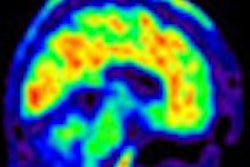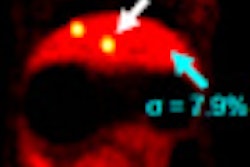Agreeing to a request from five medical imaging organizations, the U.S. Centers for Medicare and Medicaid Services (CMS) has begun taking public comment on a proposal to streamline the process by which PET imaging agents are reviewed and approved for reimbursement.
In a March 30 letter, the organizations stated that "recent advances in imaging and CMS' past experience with PET coverage no longer support a clinical rationale for a pre-emptive national noncoverage policy for new PET radiopharmaceutical agents that undergo rigorous [Food and Drug Administration (FDA)] review and approval."
The letter is cosigned by the Medical Imaging and Technology Alliance (MITA), American College of Radiology (ACR), Society of Nuclear Medicine and Molecular Imaging (SNMMI), Council on Radionuclides and Radiopharmaceuticals (CORAR), and World Molecular Imaging Society.
Fifteen years ago, PET was so novel there was "no strong evidentiary base" to adequately assess its efficacy, recalled Gail Rodriguez, PhD, MITA executive director.
"Since then, many positive coverage decisions have been released based on evidence from the National Oncologic PET Registry," she said. "There is also much more clinical experience. People know how to read these studies better, and there are many quality initiatives that manufacturers and developers have undertaken to make sure the quality of the images and quality of the interpretations are as good as possible."
Approval criteria
To be reimbursed by the Medicare program, the item or service must fall into a certain benefit category, must be "reasonable and necessary" for the diagnosis or treatment of illness or injury, and must not be specifically excluded from coverage on a basis other than medical necessity.
Currently, CMS reimburses for four tracers for clinical PET imaging: fluorine-18 (F-18) FDG, rubidium-82 (Rb-82), nitrogen-13 (N-13) ammonia, and F-18 sodium fluoride (NaF). The most recent addition to CMS coverage came in February 2010, when the agency approved reimbursement for NaF-PET to identify metastatic bone lesions in cancer cases.
FDG is the most commonly used radiotracer, and it's widely accepted for CMS coverage for managing patients with cancer. More recently, FDG-PET is being used to help assess and diagnose brain dysfunction in patients with dementia and Alzheimer's disease.
"Because it goes everywhere, FDG is good for the brain, the heart, and tumors, but it is nonspecific," said Frederic Fahey, DSc, SNMMI president and director of physics in nuclear medicine and molecular imaging at Boston Children's Hospital. "We are hoping that more specific, more targeted imaging agents will come down the pike, not just for cancer, but also for Alzheimer's disease and cardiovascular disease."
New radiopharmaceuticals
In fact, a new generation of diagnostic radiopharmaceuticals is under review in clinical trials. These agents are designed to provide more accurate information about certain diseases by detecting specific targets and characteristics.
For example, new PET imaging agents currently in development may better evaluate myocardial perfusion, the molecular processes of cellular proliferation, programmed cell death (apoptosis), angiogenesis, or hypoxia.
Other PET tracers offer the promise of assessing the risk of Alzheimer's and Parkinson's diseases, which are detected by the presence of amyloid plaque and neuroreceptor density in the brain.
Earlier this year, the FDA cleared the Amyvid (florbetapir F-18 injection) PET imaging agent from Eli Lilly and subsidiary Avid Radiopharmaceuticals for Alzheimer's disease. To satisfy FDA requirements for clearance, Lilly and Avid launched an online reader training program (AmyvidTraining.com) and collaborated with ACR for a live, in-person training program to ensure that clinicians could correctly interpret PET images with the contrast agent.
However, the use of Amyvid is not yet approved for CMS reimbursement.
As was the case with Amyvid, new radiopharmaceuticals today face a "far more rigorous regulatory environment" than they did in the previous decade, the request letter stated. The FDA requires that a product demonstrate accuracy, reliability, and clinical usefulness, and vendors must provide adequate image interpretation and radiologist training and adhere to good manufacturing practice (GMP) prior to clearance.
Duplicative process
Given that regulatory review, the five medical imaging organizations believe that CMS does not need to duplicate the process to further evaluate the efficacy of a PET radiopharmaceutical once it has gained FDA clearance.
"Some of the issues around accuracy and reliability, clinical utility and usefulness, the way physicians learn how to interpret the images, and the commitment to current good manufacturing practices have dramatically improved the environment in which PET radiopharmaceuticals now come to market," said Michael Guastella, executive director at CORAR. "The fact that you have a very stringent and rigorous FDA review and approval process supports the coverage requirements for 'reasonable and necessary' much better than it did back in [past years]."
"To layer on top of that another level of review for every possible indication is a bit difficult and cumbersome," Fahey added. "It may have been a reasonable approach in the past, but we don't feel like that may be a reasonable approach going forward."
CMS' consideration of changing its national coverage determination also reflects the nuclear medicine community's evolution toward molecular imaging, whereby imaging agents are developed for more specialized applications or "personalized medicine."
Oncologic tracers, for example, will be "very important in the way physicians make treatment decisions," said Brian Abraham, MITA senior policy director. "We feel that CMS is playing a big part in setting the table for patients to receive personalized treatment in the way that medical research had intended. Those are the [tracers] that we believe [CMS] will be able to make much quicker decisions on than what we have experienced until now."
So to avoid any "unnecessary delay" in the adoption and reimbursement of new FDA-approved PET radiopharmaceuticals, the organizations are asking CMS to revise its coverage guidelines as soon as possible.
"PET tracer developers have been working at a disadvantage for a number of years," MITA's Rodriguez added. "So, this decision, if it is a positive one by CMS, will level the playing field for them."
CMS is taking public comment on the proposed changes until August 10. More information is available by clicking here.



















